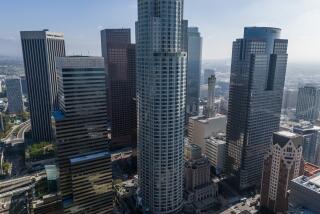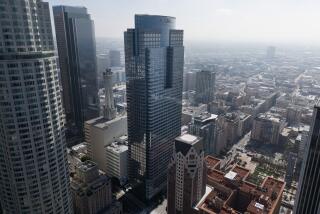A monument to the steel industry
- Share via
Martin Tower isn’t a young 38.
The 21-story world headquarters of the former Bethlehem Steel Corp. was built in 1972 as a symbol of the company’s might, and then became an emblem of the mismanagement that led to its demise.
That history is what developers are hoping will get Martin Tower, which is vacant and in need of many repairs, on the National Register of Historic Places a dozen years shy of its 50th birthday -- the age buildings usually must attain to be considered historic.
“Even though it’s not 50 years old, which is the typical threshold, Martin Tower tells a significant enough story about the Bethlehem Steel Corp. and its impact on the regional economy,” said Tony Hanna, city director of community and economic development.
Among its distinguishing features is a cruciform design that created extra corner offices for the glut of Bethlehem Steel executives.
According to the historic registry nominating form, the tower represented corporate culture’s “inward thinking” even as domestic competition, labor unrest and legacy costs loomed, foreshadowing the “deindustrialization of America.”
As the form says: “Martin Tower is the symbol of one of America’s mightiest industrial concerns as it plunged from the zenith of its power into a steady decline, ultimately leading to failure that resulted in the loss of over 100,000 jobs and regional economic hardship.”
In its glory years, Bethlehem Steel employed 30,000 workers who created the steel used in hundreds of World War II warships, the Golden Gate Bridge, the Empire State Building and other landmarks.
The once-roaring furnaces were silenced in 2001, when the company declared bankruptcy under the onslaught of foreign competition. Now the former steel plant hosts a casino.
After the company was sold to International Steel Group in 2004, there was little demand for the 600,000 square feet of offices at Martin Tower. Its shape and size weren’t attractive to investors, and the building needed a lot of work -- possibly $16.5 million alone in asbestos removal and a sprinkler system.
Martin Tower ultimately became vacant. New owners of the building are floating plans to turn it into a residential community with a mix of high-end condominiums or apartments and office space.
A historic landmark designation would make the skyscraper eligible for federal tax credits and other grants to help pay for its expensive redevelopment. Hanna said listing it on the register would help ensure that the tower -- the region’s tallest structure -- remains part of the skyline of this city of 70,000 along the Lehigh River.
The Pennsylvania Preservation Board agreed that the tower is significant and recommended this month that it be placed on the historic register. The nomination will be forwarded to the U.S. Department of the Interior for possible acceptance.
Carol Lee of the Pennsylvania Historical and Museum Commission said that the National Park Service generally accepts the state’s recommendation, but that this application is “unusual” because of the building’s age. Buildings generally must be at least 50 years old.
While it’s tougher to do, historical significance can be established for younger buildings, and Lee said the state board believes that Martin Tower’s petition makes a strong case.
Lee pointed to the headquarters of the manufacturing company Rohm and Haas in Philadelphia. That building opened in 1965. It is listed on the register in part for its innovative use of Plexiglas, the glass substitute that Rohm and Haas invented.
More to Read
Sign up for Essential California
The most important California stories and recommendations in your inbox every morning.
You may occasionally receive promotional content from the Los Angeles Times.













